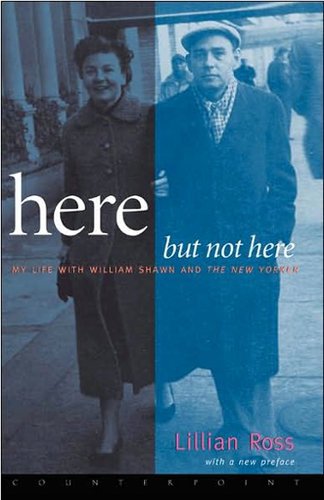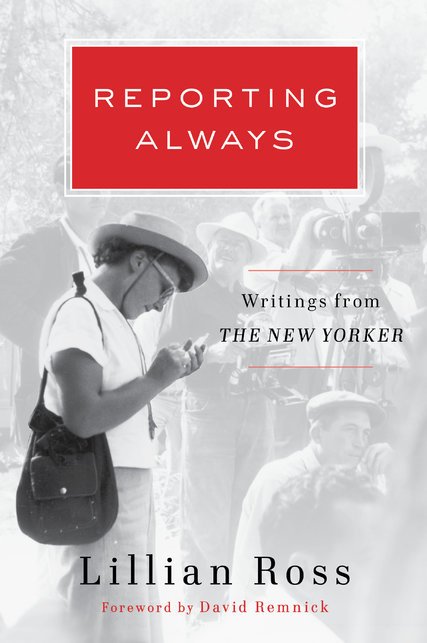She soon began writing her own Talk of the Town pieces for the magazine and went on to become a staff writer. Her profile of Hemingway on a stopover in New York — it appeared in May 1950 — elevated her into the ranks of the magazine’s most admired stylists, among them Joseph Mitchell and John Hersey.
In a later, much longer article, published in installments, she described John Huston’s anguished effort to make a great film of “The Red Badge of Courage,” Stephen Crane’s classic novel of the Civil War. When that article was ultimately reprinted as a book entitled “Picture” (1952), Newsweek called it “the best book on Hollywood ever published.”
On assignment Ms. Ross asked very few questions and never used tape recorders but filled many notebooks.

“You try not to get in the way of the person you’re trying to show,” she wrote of her technique. “You are trying to follow along the person you’re interviewing, to respond to him instead of coming along with a lot of prepared questions, you just get him going. Just don’t bother him. And listen. It’s just a question of listening.”
Here, for example, is how she depicted Louis B. Mayer, the Hollywood mogul, who opposed Huston’s idea of turning “The Red Badge of Courage” into a film (though she violated one of her cardinal rules by inserting herself into the passage):
“He pounded a commanding fist on his desk and looked at me. ‘Let me tell you something!’ he said. ‘Prizes! Awards! Ribbons! We had two pictures here. An Andy Hardy picture, with little Mickey Rooney, and “Ninotchka,” with Greta Garbo. “Ninotchka” got the prizes. Blue ribbons! Purple ribbons! Nine bells and seven stars! Which picture made the money? “Andy Hardy” made the money. Why? Because it won praise from the heart. No ribbons!’ ”
Advertisement
Continue reading the main story
Ms. Ross’s work was often cited as a precursor of the New Journalism of the 1960s, in which nonfictional material was presented in forms drawn from imaginative literature.
Her 1960 article “The Yellow Bus,” for example, had the feel of a New Yorker short story. Exquisitely detailed and warmly sympathetic, it told of a senior-class trip — of “eight hundred and forty miles in thirty-nine and a half hours” — to New York by 18 wide-eyed students from rural Bean Blossom Township High School in the village of Stinesville, Ind.
“No one in the senior class had ever talked to a Jew,” Ms. Ross wrote, “or to more than one Catholic, or — with the exception of Mary Jane Carter, daughter of the Nazarene minister in Stinesville — had ever heard of an Episcopalian.”
Writing in The New York Times Book Review in 1966, the novelist Irving Wallace called Ms. Ross “the mistress of selective listening and viewing, of capturing the one moment that entirely illumines the scene, of fastening on the one quote that Tells All.”
Her memoir, of course, relied on more than a quote to tell all. The book, which appeared six years after Mr. Shawn died at 85, unavoidably called attention to an author who had remained mostly out of view in her journalism.

She wrote about Mr. Shawn’s daily visits to the Manhattan apartment they had chosen together, where, after reading bedtime stories to Erik, the son Ms. Ross had adopted in Norway, he would leave to spend the night with his wife and his own children 11 blocks uptown.
This time her subject was not a figure she could follow around to regard and depict with clinical detachment. She was focusing on a man she had loved, a man whose widow and children were still alive. Writing as one apex of a triangle, she was uncharacteristically partisan, as she insisted that Mr. Shawn had been more contentedly and authentically himself in her company than anywhere else.
Ms. Ross openly assessed hers and Mr. Shawn’s lovemaking, reporting that over four decades it retained “the same passion, the same energies” and “the same tenderness” that it had in the beginning.
Newsletter Sign Up
Continue reading the main story
Thank you for subscribing.
An error has occurred. Please try again later.
You are already subscribed to this email.
“It never deteriorated, our later wrinkles, blotches, and scars of age notwithstanding,” she wrote. “We never changed.”
Advertisement
Continue reading the main story
The response was furious.
Charles McGrath, who had been Mr. Shawn’s deputy at The New Yorker, was among those outraged. Reviewing the book for The New York Times Book Review, where he was the editor at the time, he wrote that for Ms. Ross to publish the work while Mr. Shawn’s widow, Cecille, was “alive and vigorous” was “a cruel betrayal of the Shawns’ much-valued privacy — a tactless example of the current avidity for tell-all confessions.”
Writing in The Los Angeles Times, Jeremy Bernstein, a veteran of 31 years as a New Yorker writer, was equally scathing. Noting that the book was subtitled “A Love Story,” he commented, “It is something quite the opposite: a deeply hurtful, self-indulgent, tasteless book that never should have been written at all.”
Ms. Ross confronted the criticism over lunches with journalists.
“The controversy doesn’t make any sense to me,” she told the gossip columnist Liz Smith, who was then writing for Newsday. “Most reviewers describe Shawn as a myth in their own heads. They are bitter and full of recriminations. They want to make Bill into my victim, but he wasn’t that at all. They say I was disloyal. He wouldn’t think so; he liked being shown as he was — a tender, romantic, passionate lover, one who adored jazz and theater and fun, liked driving fast cars, was mad about good food.”

Ms. Ross had come in for criticism before the memoir was published. There were those who felt that in her hands the selective quotation could be a dagger.
Irving Howe, writing in The New Republic about her 1950 profile of Hemingway, declared, “Nothing more cruel has happened to an American writer than the Lillian Ross interview, a scream of vanity and petulance that only a journalistic Delilah would have put into print.”
Ms. Ross responded with a long letter to the magazine calling Mr. Howe’s remarks “irresponsible, rather sordid and absolutely wrong.” She said that the sketch, in which Hemingway was shown constantly drinking and speaking in a sort of telegraphic pidgin English, was an attempt to record him “just as he talked, how he sounded and looked,” and that he had seen and approved it before it ran, suggesting only one deletion.
Ms. Ross remained on friendly terms with Hemingway after her profile appeared, and he provided a blurb for “Picture,” her Hollywood book, writing, “Much better than most novels.”
She was born Lillian Rosovsky on June 8, 1918, in Syracuse to Edna and Louis Rosovsky, immigrants from Russia. She grew up in Syracuse and in Brooklyn.
Advertisement
Continue reading the main story
She knew she wanted to be a writer early on. In the introduction of “Reporting Always,” a collection of her journalism published in 2015, she wrote that she had been thrilled to see her writing in print after a junior high school teacher assigned her an article for the school newspaper about a new school library. Her lead paragraph, she recalled, began, “Fat books, thin books, new books, old books.”
Ms. Ross received a bachelor’s degree from Hunter College in New York and later did graduate work at Cornell University. Her reporting job at PM, from which she moved on to The New Yorker, was her first in journalism.
Her son, Erik, is her only immediate survivor. Ms. Ross lived on the Upper East Side of Manhattan.
Ms. Ross continued to write for The New Yorker well into the 21st century. (She left the magazine after Mr. Shawn was dismissed in 1987 but returned soon after.) Her last writing for the magazine appeared online in 2012 as a blog post about J. D. Salinger. Her last New Yorker article in print was a Talk of the Town piece in 2011 about the comedian and actor Robin Williams.
From young womanhood onward, Ms. Ross’s passion for journalism never wavered, and she was eager to impart to younger generations what she had learned on the job about writing. In her 2002 book “Reporting Back: Notes on Journalism,” she offered an assessment of what makes a good reporter:
“The act of a pro is to make it look easy. Fred Astaire doesn’t grunt when he dances to let you know how hard it is. If you’re good at it, you leave no fingerprints.”
Continue reading the main story
Article source: https://www.nytimes.com/2017/09/20/business/media/lillian-ross-dead-new-yorker-reporter-who-wrote-memoir-of-love-affair.html?partner=rss&emc=rss
Speak Your Mind
You must be logged in to post a comment.